Table of Contents
Plot
Welcome to The Mandalorian S1 E8 Review. After receiving a message from Moff Gideon, Din Djarin and his allies—Greef Karga, Cara Dune, and Kuiil—plan their final confrontation with the Imperial forces on Nevarro. The group devises a plan to infiltrate the Imperial base and rescue the Child, also known as “Baby Yoda.” As they prepare for the mission, tensions run high as they reflect on their motivations and past experiences.
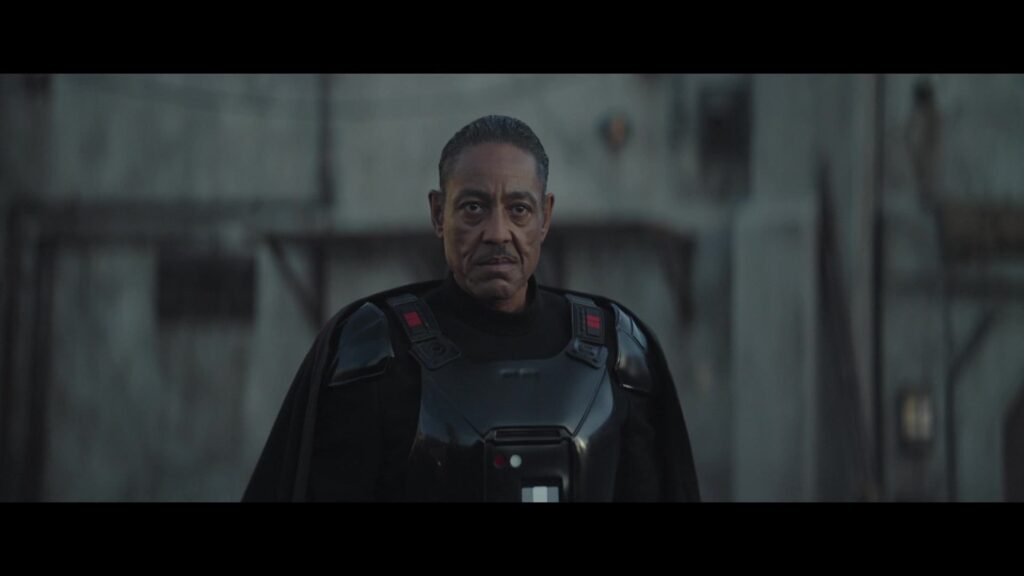
Upon reaching the Imperial base, the team faces significant challenges, including formidable stormtroopers and the imposing Moff Gideon. They manage to break into the base and locate the Child, but are soon surrounded by Gideon’s forces. A climactic battle ensues, during which Din Djarin and his allies demonstrate their resourcefulness and combat skills.
During the battle, Kuiil is tragically killed, and the Child is captured by Gideon. Realizing the danger posed to the Child, Djarin devises a plan to retrieve him, even if it means seeking unexpected assistance. Djarin seeks the help of his allies, including Greef Karga and Cara Dune, as well as a reprogrammed IG-11 assassin droid.
The group stages a daring rescue mission to the Imperial cruiser, employing various tactics and teamwork to breach the ship’s defenses. The episode culminates in a tense confrontation between Din Djarin and Moff Gideon, during which the Darksaber—a symbol of Mandalorian leadership—is used in combat.
The conclusion of the episode sees the successful rescue of the Child, with the combined efforts of the Mandalorian, his allies, and IG-11. The group manages to escape the Imperial cruiser, but not without facing challenges and sacrifices along the way.
Key Themes:
Redemption: The title of the episode, “Redemption,” reflects the theme of characters seeking to redeem themselves for their past actions. This is evident in the evolution of characters like Din Djarin and Greef Karga, who transition from self-serving to selfless motivations.
Found Family: The episode continues to emphasize the theme of found family, as the diverse group of characters come together to protect and rescue the Child. Their bond and willingness to sacrifice for one another drive the narrative forward.
Sacrifice and Heroism: The episode explores the concepts of sacrifice and heroism, exemplified by the heroic actions of characters like Kuiil and IG-11. Their willingness to give their lives for the greater good adds emotional depth to the story.
Legacy and Leadership: The introduction of the Darksaber and its significance to Mandalorian culture introduces themes of legacy and leadership. The Darksaber’s importance is tied to the leadership of the Mandalorian people, and its possession becomes a focal point of conflict.
In conclusion, Episode 8 of “The Mandalorian” Season 1, titled “Redemption,” concludes the season’s storyline with a thrilling and emotionally charged finale. The episode brings together character arcs, themes, and plot elements to deliver a satisfying and impactful conclusion to the first season.
Character development
Din Djarin (The Mandalorian):
Din Djarin’s character development reaches a pivotal moment in this episode. His journey from being a solitary bounty hunter to a protective and selfless guardian is fully realized. In “Redemption,” Djarin’s unwavering commitment to rescuing the Child demonstrates his transformation from a pragmatic individual to a selfless protector. His willingness to seek help from others, form alliances, and risk his own life reflects his growth as a person who values relationships and found family over isolation.

The Child (Baby Yoda):
While the Child’s development is not expressed through traditional dialogue, the episode highlights the depth of the connection between the Child and Din Djarin. The Child’s role as an innocent and vulnerable being in need of protection drives Djarin’s actions and decisions. The bond they share underscores the emotional core of the series and is central to Djarin’s character development.
Greef Karga:
Greef Karga’s character arc also experiences growth in this episode. Initially introduced as a self-interested leader of the bounty hunters’ guild, Karga evolves into a more compassionate and cooperative individual. His decision to aid Djarin and the others in the rescue mission demonstrates a shift from opportunism to a willingness to fight for a greater cause.
Cara Dune:
Cara Dune’s character development continues to emphasize her transition from a Rebel shock trooper to an ally and friend of Djarin. Her loyalty to Djarin and her readiness to fight for the Child reflect her transformation into a protector who values the well-being of others.
IG-11:
IG-11’s character development is particularly notable in this episode. Reprogrammed from an assassin droid to a caretaker, IG-11’s actions showcase the potential for change and growth in even the most unlikely characters. His self-sacrifice to save the others and protect the Child demonstrates his newfound purpose and heroic nature.
Moff Gideon:
Moff Gideon’s character is further explored as a formidable antagonist. His determination to capture the Child for his own purposes highlights his ruthless ambition and quest for power. Gideon’s possession of the Darksaber adds depth to his character and sets the stage for future conflicts.
In summary, Episode 8 of “The Mandalorian” Season 1, titled “Redemption,” provides a satisfying resolution to the character arcs that have been developed throughout the series. The growth, transformation, and alliances of characters like Din Djarin, Greef Karga, Cara Dune, IG-11, and Moff Gideon contribute to the emotional impact and thematic richness of the season finale.
Visual effects and cinematography
Visual Effects:
1. Imperial Cruiser: The exterior and interior of the Imperial cruiser are intricately designed with visual effects. The massive scale of the ship is portrayed convincingly, and the interiors are filled with technical details, adding to the authenticity of the setting.
2. Battle Sequences: The battle sequences are visually captivating, with blaster fire, explosions, and action choreography enhanced by visual effects. The seamless integration of practical effects and CGI creates a dynamic and engaging viewing experience.
3. Darksaber and Lightsabers: The Darksaber’s appearance and the lightsaber combat scenes are visually striking. The unique design of the Darksaber and the vibrant glow of the lightsabers stand out against the darker environments, adding visual flair to the episode.
4. Stormtrooper Interactions: The visual effects used to depict the interactions between characters and stormtroopers contribute to the realism of the combat sequences. Blaster impacts, sparks, and movement of stormtroopers are seamlessly integrated into the scenes.
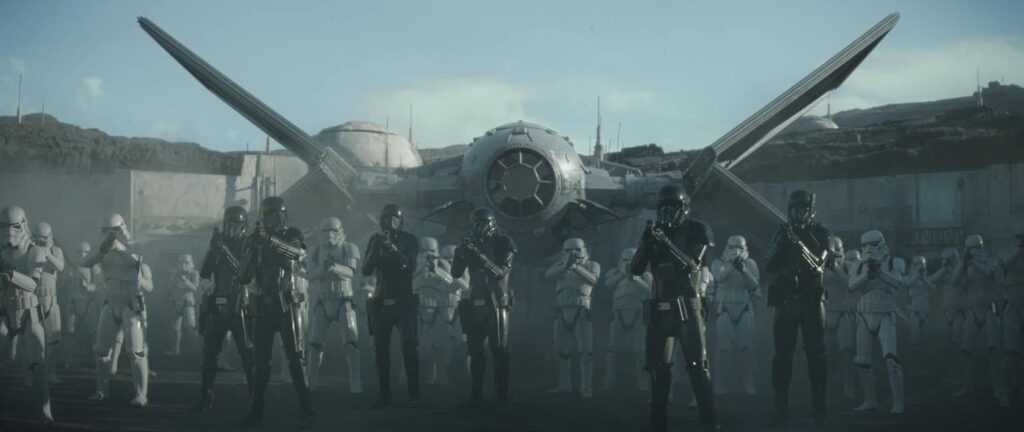
Cinematography:
1. Atmospheric Lighting: The episode’s cinematography utilizes atmospheric lighting to enhance the mood and tone of different scenes. The dimly lit interiors of the Imperial base create an eerie atmosphere, while exterior shots capture the vastness of the environment.
2. Dynamic Camera Movement: The camera movement adds energy to the action sequences. Whether it’s following characters during battles or capturing their emotions in quieter moments, the camera work contributes to the storytelling.
3. Close-Ups and Expressions: Close-up shots and detailed framing capture the characters’ expressions and emotions, allowing the audience to connect with their struggles, determination, and connections to one another.
4. Symbolic Shots: The use of symbolic shots, such as the Darksaber’s appearance and the Child’s cradle, adds depth to the narrative. These shots highlight key elements and foreshadow events, enriching the storytelling.
5. Wide Landscapes: Wide shots of the desert landscape and the Imperial cruiser emphasize the vastness of the Star Wars universe. These shots give a sense of scale and perspective to the characters’ journey.
6. Intimate Moments: The cinematography captures intimate moments between characters, showcasing their interactions and emotional bonds. These shots allow the audience to connect with the characters on a deeper level.
In summary, Episode 8 of “The Mandalorian” Season 1 features impressive visual effects and cinematography that contribute to the immersive and cinematic quality of the episode. The combination of detailed visual effects and skillful camera work enhances the action sequences, character interactions, and overall storytelling, making it a visually captivating viewing experience.
World-building
Nevarro – Imperial Base and Town:
The episode primarily takes place on Nevarro, a planet previously visited in earlier episodes. The world-building of Nevarro is further developed as the audience is exposed to the intricacies of the Imperial base. The base’s architecture, interior designs, and the presence of stormtroopers contribute to the atmosphere of an Imperial-controlled territory. Additionally, the depiction of the town on Nevarro showcases the town’s transformation since the events of previous episodes.
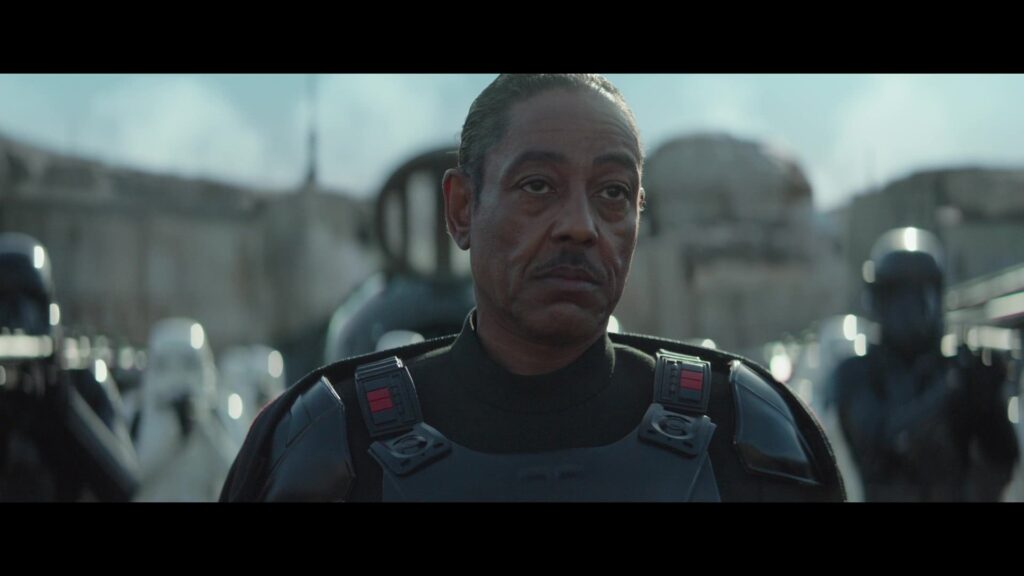
Imperial Cruiser:
The introduction of an Imperial cruiser adds a new dimension to the Star Wars universe. The cruiser’s interiors, including the detention cells and control rooms, showcase the technological advancements and design aesthetics of the Imperial forces. The presence of Moff Gideon and his forces aboard the cruiser underscores the reach of the Imperial Remnant.
Darksaber and Mandalorian Culture:
The episode deepens the exploration of Mandalorian culture through the introduction of the Darksaber. The significance of the Darksaber as a symbol of leadership and honor among the Mandalorians adds a layer of complexity to the Mandalorian lore. This world-building element connects “The Mandalorian” to broader Star Wars narratives and lore.
Spaceship and Technology Design:
The attention to detail in the spaceship and technology designs continues to immerse viewers in the science fiction universe. The episode showcases the unique design of the Razor Crest and the Imperial cruiser, each with their own distinctive visual and functional characteristics.
Landscape and Environments:
The landscapes of Nevarro, from the barren deserts to the industrialized town, contribute to the diversity of the settings. These environments add visual variety and context to the characters’ actions and decisions, enhancing the overall world-building.
Cultural References:
The episode references the broader Star Wars universe through the inclusion of characters like Bo-Katan Kryze and the Darksaber. These references deepen the connection between “The Mandalorian” and other media within the franchise.
Cultural Practices and Customs:
Through characters like Din Djarin and the Armorer, the episode delves into Mandalorian practices and customs, showcasing the significance of the helmet, the creed, and the importance of found family.
In summary, Episode 8 of “The Mandalorian” Season 1 further enriches the world-building of the Star Wars universe. It expands on existing locations, introduces new elements such as the Imperial cruiser, and explores the cultural aspects of Mandalorian society. These world-building elements contribute to the depth and immersion of the narrative, creating a compelling and authentic galaxy far, far away.
Action and direction
Action Sequences:
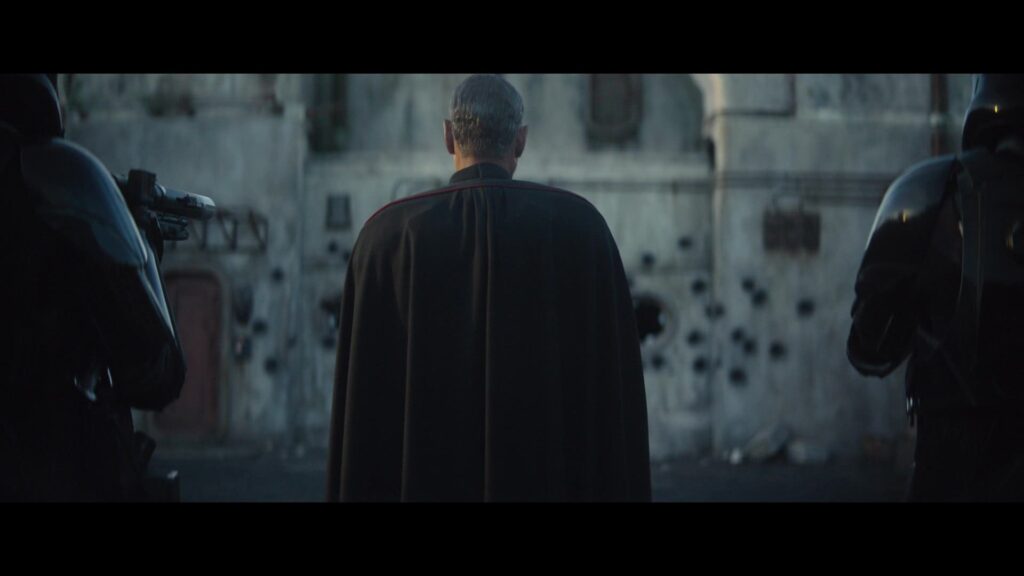
1. Imperial Base Infiltration: The episode kicks off with an intense action sequence as Din Djarin and his allies infiltrate the Imperial base on Nevarro. The strategic use of blasters, cover, and teamwork creates a sense of urgency and danger.
2. Battle Against Stormtroopers: As the team faces off against waves of stormtroopers, the action choreography is dynamic and engaging. The blaster exchanges, explosions, and tactical maneuvers showcase the combat prowess of the characters.
3. Confrontation with Moff Gideon: The climactic battle between Din Djarin and Moff Gideon is a standout action sequence. The duel involves close-quarters combat, the use of the Darksaber, and a tense standoff. The choreography and direction contribute to the intensity of the encounter.
4. Escape from the Imperial Cruiser: The episode’s closing sequence features a daring escape from the Imperial cruiser. The action aboard the ship involves blaster fire, close calls, and strategic decision-making as the characters work together to evade the Imperial forces.
Direction:
1. Pacing and Tension: Taika Waititi’s direction effectively balances pacing and tension throughout the episode. The action sequences are interspersed with moments of emotional depth and character interactions, creating a well-rounded viewing experience.
2. Character Moments: Waititi’s direction allows for intimate character moments that reveal emotions and motivations. Close-up shots and interactions emphasize the bond between characters and the stakes of their mission.
3. Visual Composition: The visual composition of scenes, from wide shots of the landscapes to detailed close-ups of characters, adds depth and dimension to the storytelling. The framing and camera angles contribute to the audience’s engagement with the narrative.
4. Emotional Resonance: The direction brings out the emotional resonance of key moments, including Kuiil’s sacrifice and IG-11’s redemption. These scenes are handled with sensitivity, allowing the audience to connect with the characters on a deeper level.
5. Symbolic Shots: Waititi employs symbolic shots to highlight significant elements, such as the Darksaber and the Child’s cradle. These shots foreshadow events and add thematic depth to the episode.
6. Cinematic Aesthetic: The episode’s direction maintains a cinematic aesthetic, enhancing the scope and scale of the Star Wars universe. The direction captures the grandeur of the action sequences while also focusing on character-driven storytelling.
In summary, Episode 8 of “The Mandalorian” Season 1 masterfully combines action and direction to create a compelling and immersive viewing experience. Taika Waititi’s direction brings out the best of both worlds, delivering thrilling action sequences while also emphasizing character growth, emotion, and the overall narrative arc.
Music and sound design
Music by Ludwig Göransson:
1. Thematic Leitmotifs: Göransson’s use of recurring leitmotifs enhances the episode’s storytelling. Iconic themes associated with characters, such as the Mandalorian’s theme and the Child’s theme, reappear during crucial moments, reinforcing the emotional weight of their actions.
2. Tension and Suspense: The music underscores the tension and suspense during action sequences and pivotal confrontations. The intensity of the score heightens the viewer’s anticipation and enhances the impact of each scene.
3. Darksaber Theme: The introduction of the Darksaber is accompanied by a distinctive theme that adds an air of mystery and significance to the weapon. The music complements the visual and narrative impact of the Darksaber’s appearance.
4. Emotional Resonance: Göransson’s compositions evoke emotional resonance during character-driven scenes. Moments of reflection, sacrifice, and connection are enhanced by the musical score, allowing the audience to empathize with the characters’ experiences.
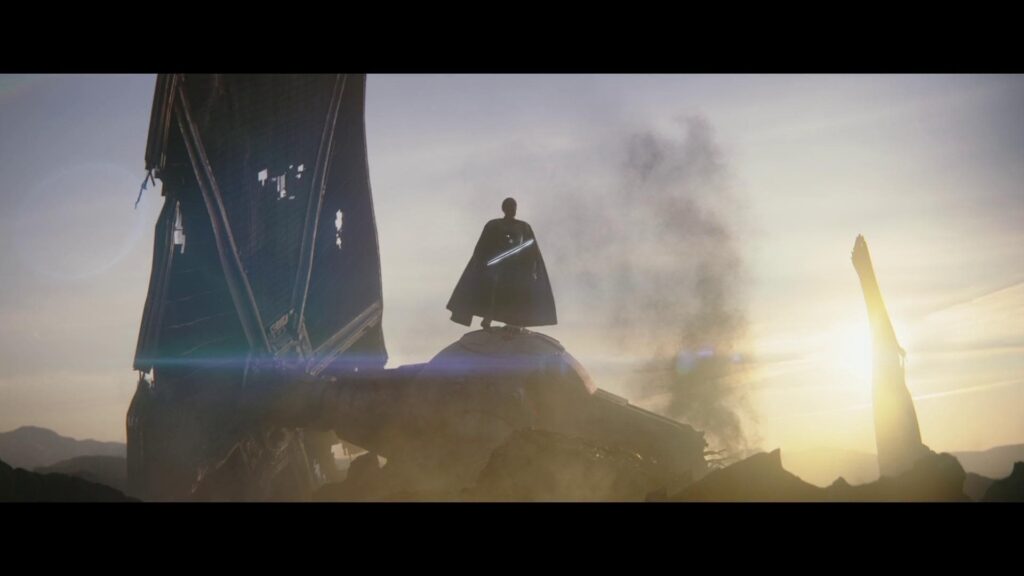
Sound Design:
1. Blaster Fire and Explosions: The sound design team meticulously crafts the audio effects of blaster fire, explosions, and combat sequences. The realistic and impactful sound effects immerse the viewer in the action and enhance the visual elements.
2. Spaceship Ambience: The sound design contributes to the authenticity of spaceship interiors and exterior environments. The hum of engines, the mechanical sounds of ship controls, and the ambience of different locations enrich the sensory experience.
3. Lightsaber and Darksaber Sounds: The distinct hums and clashes of lightsabers and the Darksaber are faithfully recreated. These iconic sounds resonate with Star Wars fans and enhance the authenticity of the battles.
4. Character Interactions: The sound design captures the nuances of character interactions, from the tone of their voices to the subtleties of facial expressions. These audio details deepen the emotional impact of the dialogue and performances.
5. Mood Enhancement: The sound design enhances the mood and tone of scenes, whether it’s the tension of the battles, the quiet moments of reflection, or the moments of triumph and sacrifice. The soundscapes contribute to the overall atmosphere of the episode.
6. Creature Sounds: The episode features various creatures and beings, each with its own distinct vocalizations and sounds. The sound design team brings these creatures to life, adding to the richness of the Star Wars universe.
In summary, Episode 8 of “The Mandalorian” Season 1 showcases the mastery of both music and sound design in enhancing the episode’s impact and emotional resonance. The collaborative efforts of composer Ludwig Göransson and the sound design team create a multisensory experience that immerses the viewer in the world of “The Mandalorian.”
Pacing and episode structure
Three-Act Structure:
Act 1 – Infiltration and Set-Up:
The episode begins with a sense of urgency as Din Djarin and his allies plan to infiltrate the Imperial base on Nevarro. This act establishes the mission’s objectives, introduces the stakes, and reestablishes the dynamic between the characters. The pacing is brisk, and tension is built through suspenseful planning and preparation.
Act 2 – Confrontation and Challenges:
The second act intensifies as the characters execute their plan within the Imperial base. The action ramps up with battles against stormtroopers and the discovery of the Child. The pacing alternates between action-packed sequences and character interactions, deepening emotional connections and revealing motivations. The challenges faced by the characters add complexity to the narrative, culminating in the climactic confrontation with Moff Gideon.
Act 3 – Resolution and Escape:
The final act focuses on resolution and escape. Character arcs are fulfilled as alliances are solidified, sacrifices are made, and resolutions are reached. The action sequences in this act are punctuated by emotional moments, highlighting the characters’ growth and relationships. The episode’s pacing slows down to allow for reflection, character interactions, and closure before the triumphant escape from the Imperial cruiser.
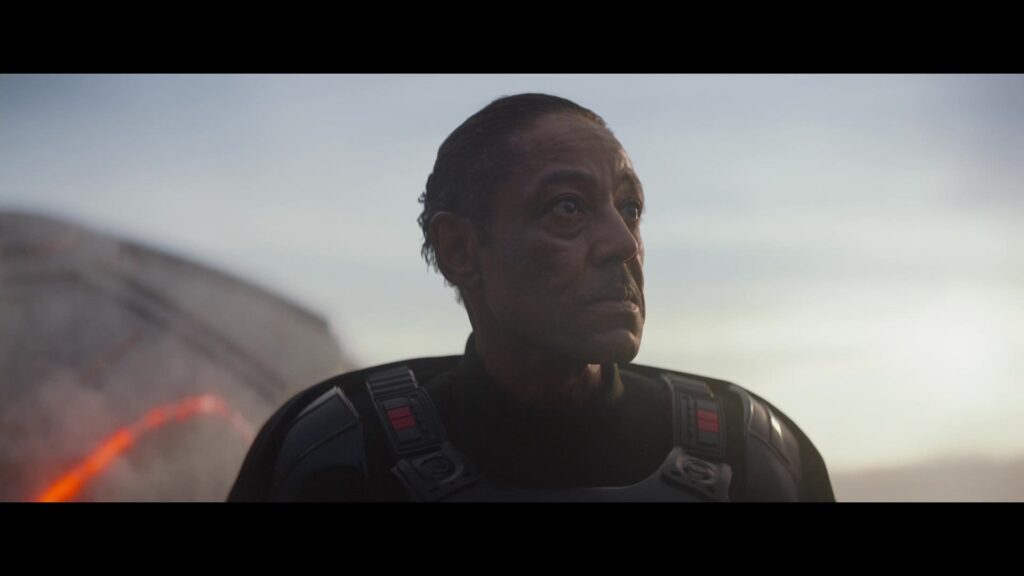
Pacing and Tension:
The pacing of the episode is dynamic and deliberate, ensuring that the audience remains engaged from start to finish. Action sequences are balanced with quieter character-driven moments, preventing the episode from feeling overly frenetic. Tension is carefully built and released throughout the episode, enhancing the emotional impact of key scenes. The pacing effectively leads the viewer through the episode’s narrative arc, from the initial infiltration to the final escape.
Emotional Resonance:
The episode structure provides ample room for emotional resonance. Moments of character introspection, sacrifice, and connection are given space to breathe, allowing the audience to fully absorb the characters’ experiences. The episode’s pacing creates a sense of investment in the characters’ outcomes, enhancing the impact of their choices and actions.
Cohesive Narrative:
The episode’s structure maintains a cohesive narrative that brings together various plot threads, character arcs, and themes developed throughout the season. The pacing allows for the resolution of ongoing conflicts while introducing new elements that lay the groundwork for future storytelling.
In summary, Episode 8 of “The Mandalorian” Season 1 exhibits a well-balanced pacing and episode structure that guides the audience through an immersive and emotionally resonant experience. The three-act structure effectively blends action, character development, and resolution, resulting in a satisfying conclusion to the season while setting the stage for future adventures.
Originality and innovation
Originality:
1. Found Family Theme: “The Mandalorian” explores the concept of found family in a way that distinguishes it from previous Star Wars narratives. The dynamic between Din Djarin and the Child, as well as his evolving relationships with other characters, adds depth and emotion to the series.
2. Focus on Mandalorian Culture: The series delves into the intricacies of Mandalorian culture, traditions, and creed. This exploration adds an original layer to the Star Wars universe, shedding light on a lesser-explored aspect of the lore.
3. Character-Driven Storytelling: “Redemption” continues the series’ emphasis on character-driven storytelling. The episode prioritizes character development, relationships, and emotions, creating a more intimate and relatable narrative within the expansive Star Wars universe.
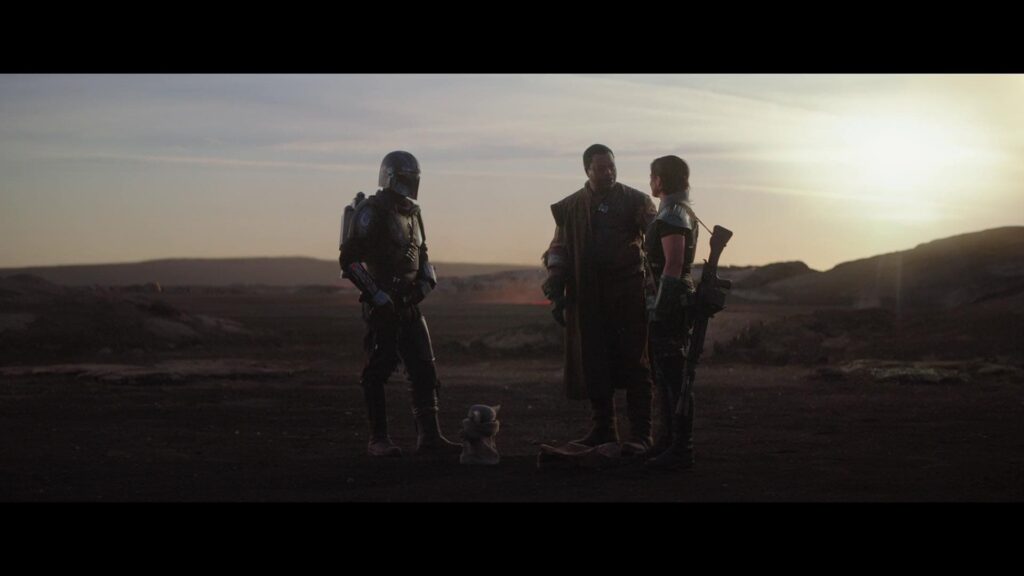
Innovation:
1. Visual Effects and Technology: The use of groundbreaking technology, including the StageCraft technology for virtual sets, is a significant innovation. This technology enables real-time rendering of backgrounds, enhancing the visual fidelity and realism of the show’s settings.
2. Cinematic TV Experience: “The Mandalorian” pioneers a cinematic television experience, with each episode feeling like a self-contained mini-movie. This approach challenges traditional episodic TV storytelling and raises the bar for production values in the streaming era.
3. Introduction of Darksaber: The Darksaber’s introduction brings an innovative element to the series. The inclusion of this unique Mandalorian weapon opens the door to exploring Mandalorian history, politics, and leadership in future episodes.
4. Character Redemption and Evolution: The episode innovatively subverts expectations by exploring character redemption and evolution. IG-11’s transformation from assassin droid to protector and Kuiil’s heroic sacrifice add depth to characters that might have been overlooked in traditional storytelling.
5. Cross-Media Integration: “The Mandalorian” innovatively integrates elements from various Star Wars media, including animated series like “The Clone Wars” and “Rebels.” This cross-media approach rewards dedicated fans and enriches the viewing experience for those familiar with the broader lore.
6. Episodic Arc with Overarching Narrative: The series innovates by combining episodic storytelling with an overarching narrative. Each episode features its own storyline while contributing to the larger narrative arc of the Mandalorian’s journey and the fate of the Child.
In conclusion, Episode 8 of “The Mandalorian” Season 1, titled “Redemption,” continues to showcase the series’ originality and innovation within the Star Wars universe. Its unique themes, focus on character-driven storytelling, technological advancements, and integration of various storytelling elements make “The Mandalorian” a standout example of how to innovate within an established franchise.
Fan appeal and Easter eggs
1. Character Returns: The episode features the return of Greef Karga and Cara Dune, characters introduced earlier in the season. Their return appeals to fans who have grown attached to these characters and their dynamic with the Mandalorian.
2. Darksaber and Bo-Katan Kryze: The inclusion of the Darksaber and the appearance of Bo-Katan Kryze serve as major fan appeals. Bo-Katan’s introduction bridges the gap between animated series like “The Clone Wars” and “Rebels” and the live-action show, exciting fans familiar with her backstory.
3. Character Moments: The emotional character moments, such as Kuiil’s sacrifice and IG-11’s redemption, resonate with fans who have invested in these characters’ journeys throughout the season.
4. Action Sequences: The thrilling action sequences featuring blaster fire, lightsabers, and the Darksaber cater to fans of fast-paced Star Wars battles.
Easter Eggs:
1. Dark Troopers: The appearance of Dark Troopers, advanced battle droids from Star Wars Legends, serves as an Easter egg for fans well-versed in expanded Star Wars lore.
2. Darksaber History: The introduction of the Darksaber and its history within Mandalorian culture is an Easter egg that ties the series to the broader Star Wars lore established in animated series.
3. Imperial Remnant: The depiction of the Imperial Remnant and its forces continuing after the fall of the Empire pays homage to the extended universe and provides context for the post-Return of the Jedi era.
4. Razor Crest Repairs: The sequence involving the repairs of the Razor Crest echoes the do-it-yourself repairs commonly seen in the Star Wars franchise, adding a touch of familiarity for fans.
5. Sound Effects: Familiar sound effects, such as the hum of lightsabers and the distinct sound of the Darksaber, trigger recognition and excitement among fans.
6. Moff Gideon’s Dialogue: Moff Gideon’s dialogue references the history and significance of the Darksaber, serving as an Easter egg for fans familiar with Mandalorian lore.
7. IG-11’s Reveal: IG-11’s reprogramming and transformation from an assassin droid to a protector serves as a nod to the series’ ability to subvert expectations and create surprise moments for fans.
In summary, Episode 8 of “The Mandalorian” Season 1, titled “Redemption,” carefully integrates fan appeal and Easter eggs to enrich the viewing experience. These elements pay homage to the broader Star Wars universe, create moments of excitement and recognition, and reward dedicated fans with references to established lore and characters.
FAQs
What is the significance of the Darksaber in “The Mandalorian”?
The Darksaber is an ancient and unique black-bladed lightsaber, symbolizing leadership among the Mandalorians. Its appearance in the series connects to Mandalorian history and culture, sparking intrigue and anticipation for its future role.
Who is Bo-Katan Kryze, and why is her appearance important?
Bo-Katan Kryze is a Mandalorian warrior and leader with ties to “The Clone Wars” and “Rebels” animated series. Her appearance in “The Mandalorian” bridges the gap between these series and the live-action show, offering insights into Mandalorian politics and lore.
What is the role of Moff Gideon in the series?
He is an ambitious Imperial officer who seeks to capture the Child for mysterious reasons. His possession of the Darksaber raises questions about his intentions and connections to Mandalorian history.
What is the fate of the Child (Baby Yoda) in this episode?
The Child’s safety is a central concern throughout the season, and in this episode, he is rescued from Moff Gideon’s grasp by Din Djarin and his allies. The successful rescue demonstrates the lengths the characters are willing to go to protect him.
How does “Redemption” set up future storylines?
The episode’s conclusion hints at the potential for conflict and further exploration of the Darksaber’s significance. Moff Gideon’s survival and possession of the Darksaber suggest that his role will continue to be important in future seasons.
